Danang has a developed network of roads, railways, sea and air routes. The main roads are sealed. Danang train station is one of the biggest in Vietnam. Danang has shipping routes to most of the big domestic and international ports. Danang International Airport can handle B747, B767 and A320 aircrafts. There are 84 domestic flights, and 6 international ones to Hong Kong and Thailand, weekly. In the coming period, when the projects to upgrade seaports, railway stations, roads and the Danang International Airport are finished, Danang will have a completed infrastructure system In addition, the city’s water and electricity supply and communication system have been quickly developed and modernised, ranking third after Hanoi and Ho Chi Minh City.
Danang International Airport
According to the ICAO evaluation, the Danang airport could be an alternative transit point on the Europe-Asia Pacific international route as it is located in the Central Asia near the sea with ideal flying level. Currently, there are more than 30 airlines of 20 countries operating in the Danang air space. From Danang, there are not only domestic flights to Hanoi, Hochiminh city, Hai Phong, Hue, Quy Nhon, Nha Trang, Pleiku, ect. but also international ones to Bangkok (Thailand), Hong Kong (China), Vientiane (Laos), Phnompenh (Cambodia), Taipei (Taiwan)... |
Danang Port
Danang Port is 310 nautical miles from Hai Phong Port, 520 nautical miles from Sai Gon Port, 550 nautical miles from Hong Kong, 610 nautical miles from Kao Slung (Taiwan), 720 nautical miles from Manila (Philippines), 860 nautical miles from Komponchom (Cambodia), 960 nautical miles from Singapore, 1,030 nautical miles from Taipei (Taiwan), 1060 nautical miles from Satalip (Thailand), 1,400 nautical miles from Malaysia, 2045 nautical miles from Shang Hai, and 2,340 nautical miles from Yokohama (Japan). The Danang port has sufficient modern facilities to satisfy customers’ demands including 7 tugboats from 305HP to 1750 HP; 16 mobile cranes from 5 to 8 tons; 19 forklifts from 1.5 tons to 42 tons, including two reach stackers of 42 tons; 6 tractors; 11 excavators and 25 trucks of all kinds. With its favorable location, modern equipment and highly skilled staff, Danang port is involved in: handling, delivering, receiving and storing cargo; piloting vessels in and out of the port; trading in land and marine transportation; cargo transporting; trading in port yards and warehouses; repairing vessels and vehicles; shipping cargo to some foreign countries; goods service and others. Number of international ships go directly from
|
Danang Railway Station
The Danang railway station was built and inaugurated in 1902 under the domination of the French based on the synchronized architecture from north to south. Since its establishment, much reconstruction and many improvements have been made, so there is no trace of the old architectural style. After the complete liberation of South Vietnam, Danang railway station was expanded to become a sectional unit with 3 functions: freight, travelers and technology demonstration stations. Currently, Danang railway station is considered the biggest and most well-equipped one in Central Vietnam. It has been upgraded to be spacious and comfortable with an air-conditioned and well-equipped 200-person waiting lounge and can supply travelers with many additional services such as restaurants, bars, public telephone boxes, newspaper shops, washrooms and toilets. Security and order here are also assured. |
Road System
Of the 77 bridges in the city, 34 are permanent and 43 are temporary. Tourist transportation: There are 30 new style well equipped means of transport that meet aesthetic and technical demands. They are periodically quality-tested, license-granted and insured by tourist administration, and transportation and public works agencies. Most of the drivers have been trained in foreign language and tourist service courses. Transportation for Public Travelers: The Danang enterprise of passenger transportation and trading services has 3 coach stations at 31, 33 and 35 Dien Bien Phu street, Thanh Khe district that can serve the city and other cities and provinces nationwide, and to Savanakhet province (Laos). Bus: With 30 buses, the Danang bus system can serve the inner city and suburbs and Quang Nam province’s localities such as Hoi An, Tam Ky, Nam Phuoc and Ai Nghia. They all have good quality with polite services and reasonable prices. At every bus stop, there are guide boards and shelter. Taxi: There are 4 taxi companies operating in the city: Dana Taxi (Tel: 84.511.815815), Airport Taxi (Tel: 84.511.825555), Huong Lua Taxi (Tel: 84.511.828282), and Song Han Taxi (Tel: 84.511.655655) and Song Han Taxi (Tel: 84.511.655655). They are relatively good and convenient. Each company has a different service price, ranging from 6,000 to 7,000 VND per kilometer. Motorbike and pedicab services: Many motorcycles and pedicabs can be found in front of hotels, restaurants, tourist sites, recreation parks and main streets of the city to serve tourists. At some hotels and in main streets attracting the large number of tourists, the local government has established some self-managed pedicab teams to coordinate in managing, informing service price, and keeping social security and order. |
Post-Telecommunication Network
Transmission network includes 9 provincial transmission routes using fiber optic cable systems and 3 ones using micro-wave. The whole network currently comprises 80 kilometers of cables, 110,000 copper bi-cables, 175,258 kilometers of bi-cables, 305 kilometers of pipes, 369 kilometers of post lines, 1,899 cable tanks, 733 cable boxes and 3,537 cable chests. Currently, Danang has 21 types of switchboards, including 02 OCB EB switchboards with a total installment volume of 80,818 digits. By October 2003, there are total 128,249 subscribers in the city, including 32,523 mobile ones. Subscriber density: 17.3 telephones per 100 head. All 14 villages and 9 border protection stations are also equipped with telephones. Internet subscribers: 16,970; Pagers: 814; There are 62 post offices in the city. Of these, one is first level, 5 are second level, 56 are third level and 12 are communal cultural level. The city post network satisfies all customers’ demand. The city has 04 delivery routes of second level with 90 kilometers long, and 32 ones of third level served by four-wheel vehicles with 457 kilometers long. |
Power Supply System
|
Water Supply System
- The Cau Do water supply plant utilizes a horizontal settling tank, a quick filter tank - liquid chlorine with its capacity of 50,000 m3 per day. - The San Bay water supply plant utilizes a radian settling tank, a quick filter tank - liquid chlorine with its capacity of 20,000 m3 per day. - The Son Tra water supply plant utilizes a pressure filter tank - liquid chlorine with its capacity of 5,000 m3 per day. By using the river water as the main source, the water needs for daily activities and production of the local people and other organizations can be satisfied. With a total length of F100-900 pipes of nearly 200 kilometers, the number of people using fresh water is as many as 276,041; accounting for 38.18% of the population (based on the statistics of the year 2000). Of them, the inner-city and rural areas accounted for 266,514 and 9,572, making up 46.72% and 6.25% respectively. |

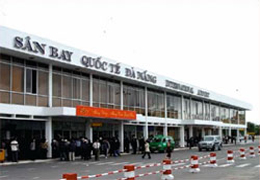 Located very near the city center, Danang international airport is one of the three largest in Vietnam after Tan Son Nhat and Noi Bai airports and has a total area of 842 hectares of which the civil aviation section is allocated 150 hectares. Built in 1940, the Danang airport currently has 2 modern and well-equipped runways with 3,048 meters long and 45 meters wide of each, capable of handling big crafts such as B747, B767 and A320 landing safely in any weather condition.
Located very near the city center, Danang international airport is one of the three largest in Vietnam after Tan Son Nhat and Noi Bai airports and has a total area of 842 hectares of which the civil aviation section is allocated 150 hectares. Built in 1940, the Danang airport currently has 2 modern and well-equipped runways with 3,048 meters long and 45 meters wide of each, capable of handling big crafts such as B747, B767 and A320 landing safely in any weather condition.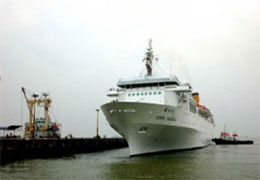 Danang port is at latitude 16017’33” North and longitude 180020’30’’East. The pilot station is at latitude 16010’North and longitude 180011’East. It is influenced by semi-diurnal tides with the average water level difference being 0.9 meter. Danang port network consists of Tien Sa Sea Port and the Han River Port. The total yard area is 125,350 m2 and the total warehouse area is 22,764 m2. The length of berths is 1,647 m2 and total area of berths is 27,633 m2. The Port’s throughput is 3-4 million tons per year.
Danang port is at latitude 16017’33” North and longitude 180020’30’’East. The pilot station is at latitude 16010’North and longitude 180011’East. It is influenced by semi-diurnal tides with the average water level difference being 0.9 meter. Danang port network consists of Tien Sa Sea Port and the Han River Port. The total yard area is 125,350 m2 and the total warehouse area is 22,764 m2. The length of berths is 1,647 m2 and total area of berths is 27,633 m2. The Port’s throughput is 3-4 million tons per year.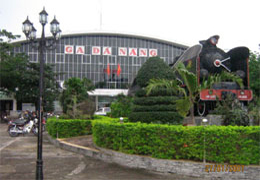 Located in the inner city, Danang railway station is one of the biggest ones on the North-South rail route and is part of the national rail system. There are 29 train trips from Hochiminh city and Hanoi to Danang every week. From Danang, it is possible for travelers to buy tickets to all stations nationwide.
Located in the inner city, Danang railway station is one of the biggest ones on the North-South rail route and is part of the national rail system. There are 29 train trips from Hochiminh city and Hanoi to Danang every week. From Danang, it is possible for travelers to buy tickets to all stations nationwide.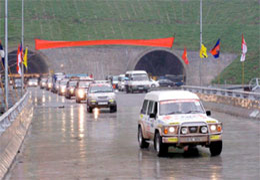 Danang has a comparatively good road network. The total length of the city’s roads is 382,583 kilometers (apart from alleys and pathways). This includes 70,865 kilometers of national routes, 99,716 kilometers of provincial routes, 67 kilometers of rural roads and 81,672 kilometers of inner-city roads. The roads are 8 m wide on average. Road density varies from 3 km/km2 in the central city areas to 0.33 km/km2 in rural areas.
Danang has a comparatively good road network. The total length of the city’s roads is 382,583 kilometers (apart from alleys and pathways). This includes 70,865 kilometers of national routes, 99,716 kilometers of provincial routes, 67 kilometers of rural roads and 81,672 kilometers of inner-city roads. The roads are 8 m wide on average. Road density varies from 3 km/km2 in the central city areas to 0.33 km/km2 in rural areas.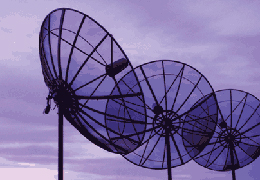 Being one of the three major centers of the national post-telecommunication network, on the international cable line with the international sea cable station in the area of Hoa Hai ward, Ngu Hanh Son district of Danang City, sufficient for meeting demand of organizations, individuals in the city area, Central Vietnam and the Central Highlands.
Being one of the three major centers of the national post-telecommunication network, on the international cable line with the international sea cable station in the area of Hoa Hai ward, Ngu Hanh Son district of Danang City, sufficient for meeting demand of organizations, individuals in the city area, Central Vietnam and the Central Highlands.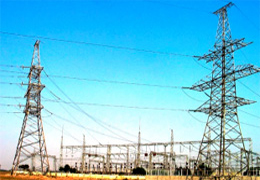 Danang is provided with electricity from the Hoa Binh hydroelectric plant through the North-South 500KV high voltage line to meet the local demand for consumption and production. Currently, because the old 35-220KV transformer grid is used, the electricity loss is considerable. Some communes in Hoa Vang district have no electricity or the voltage is not high enough for their production and daily activities. Currently, the city authorities are investing in expanding and renovating the grid transformer system.
Danang is provided with electricity from the Hoa Binh hydroelectric plant through the North-South 500KV high voltage line to meet the local demand for consumption and production. Currently, because the old 35-220KV transformer grid is used, the electricity loss is considerable. Some communes in Hoa Vang district have no electricity or the voltage is not high enough for their production and daily activities. Currently, the city authorities are investing in expanding and renovating the grid transformer system.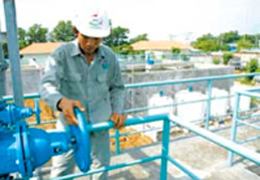 Currently, there are 3 water supply plants in the city.
Currently, there are 3 water supply plants in the city.